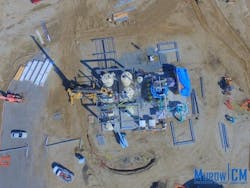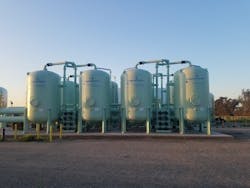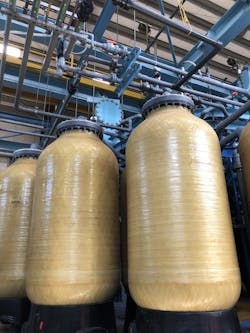Continuous IX in Chino
About the author:
Christy Bostardi is marketing manager of drinking water solutions for Calgon Carbon Group. Bostardi can be reached at [email protected].
The city of Chino sits below the San Bernardino Mountains 35 miles east of Los Angeles. The area has been known since the 1950s for its agricultural industry, including orchards, crops and one of the largest concentrations of dairy farms in the country.
With increasing demand for residential development, the area has gradually transitioned from farms to homes. Chino’s population increased from 78,000 in 2010 to 90,000 in 2017, according to the U.S. Census Bureau, and the area projects its population to dramatically increase further in the coming years.
Such growth has required the city to expand its groundwater production capacity. However, nitrate contamination has stymied those efforts, since some groundwater wells have been unusable due to poor water quality. Agricultural activity involving fertilizer and livestock has contributed to levels of nitrate measuring as high as 150 ppm in some of the wells of the Chino Groundwater Basin, which serves as a major water source for the city of Chino and several other nearby communities. The geographic position of Chino exacerbates this challenge.
“The gradient is such that everything is going to flow south, so with Chino at the very southern end of the Chino Groundwater Basin, we know that we’re going to see other contaminants flow southerly,” said Gilbert Aldaco, retired water superintendent for the city of Chino.
To serve a greater population, the city needed to expand its groundwater supply and find a solution to remove nitrate as well as perchlorate and emerging contaminants, such as hexavalent chromium and 1,2,3-TCP, from its groundwater. These solutions needed to be installed at two water treatment plants: the Benson Water Treatment Facility, which treats two wells, and the recently built Eastside Water Treatment Facility, which treats three wells, and which the city finished constructing in 2016.
For both projects, the city of Chino partnered with Calgon Carbon.
Using ISEP for Nitrate Removal
To utilize groundwater sources and meet increasing demand, the Chino finalized a plan for nitrate treatment for its Benson Water Treatment Facility in 2003. At the time, the city considered bioremediation, fixed bed ion exchange (IX), reverse osmosis (RO), and Calgon Carbon Ion Separator (ISEP) technology. To make an informed decision, certain considerations were taken into account, such as the approval of technology by the California Department of Health Services, the success rate of previous installations and operations of nitrate removal systems, and the amount of waste produced by the process.
The city of Chino chose the ISEP system because it requires less capital, produces more concentrated waste brine—which minimizes transportation costs—requires no additional well site storage, and has higher water recovery. Also, the Calgon Carbon ISEP system had been successfully used at nearby sites for perchlorate removal.
Construction of the ISEP system at the Benson Water Treatment Facility was completed in 2005. Chino chose to install the same ISEP system in 2013 when it began construction on the Eastside Water Treatment Facility. The system allows the removal of nitrates, chlorite, and hexavalent chromium in 3,500 gallons per minute of groundwater.
ISEP reduced the presence of nitrates from 150 ppm to between 20 to 25 ppm. The standard for drinking water is 45 ppm. The city’s goal of reducing waste from the process was achieved, as waste is 2/10 to 3/10 of 1%, according to Charles Drewry, national sales manager for the drinking water solutions business line of Calgon Carbon.
The ISEP system became operational in the spring of 2015 and has allowed the city to achieve “very steady water quality,” Drewry said.
“By steady, I mean if they want to have 22 ppm of nitrogen coming out of the system, they can dial it into the system and hit that number,” he said.
The system also requires little hands-on work, Drewry added.
“[ISEP] does not take a lot of operator attention when compared with other technologies,” he said. “It’s more of a day-to-day check. Other than that, it’s pretty much standalone.”
Installing a 1,2,3-TCP Solution
The city of Chino recently partnered with Calgon Carbon to reduce another contaminant in its groundwater supply against a strict timetable. In 2017, Chino addressed 1,2,3-TCP contamination found in its groundwater to ensure compliance with updated state water regulations set earlier that year. The city had less than a year to implement a system to reduce its 1,2,3-TCP to five parts per trillion or be found in violation of the California Safe Drinking Water Act.
“The project was on a fast-track basis. This type of project usually takes a year to a year-and-a-half,” said Robert Foster, president of RC Foster Corporation, which was awarded the bid for the project. The contractor had five months to have the system installed at both facilities.
Chino indicated it wanted a liquid phase granular activated carbon system. RC Foster teamed with Calgon Carbon to complete the work with the company’s Filtrasorb 400 granular activated carbon and eight Model 10 systems; four at the Eastside Water Treatment Facility and four at the Benson Water Treatment facility.
“We did not consider another vendor for the project,” Foster said. “We chose and teamed with Calgon Carbon to provide the proposal and to build the final product.”
The city also chose to use reactivated carbon for its system.
“It’s dollars and cents,” Aldaco said. “You can take fresh carbon, dispose of it properly and refill it with virgin carbon, but it can be expensive to do that…The reactivated carbon is more economical.”
The team was able to meet the project deadline “almost right down to the day,” Foster said.
“Everybody was invested and wanted to make sure the job got done on time,” he said. “There was a good vendor on board, a lot of experience with this type of work, and the city of Chino was very proactive with their side of things.”


